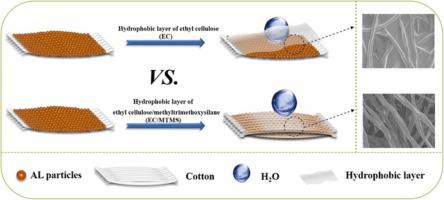Industrial Crops and Products ( IF 5.6 ) Pub Date : 2022-05-02 , DOI: 10.1016/j.indcrop.2022.114993 Yu-Hui Jiang 1 , Yu-Qing Zhang 1 , Zhan-Hua Wang 2 , Qing-Da An 1 , Zuo-Yi Xiao 1 , Ling-Ping Xiao 1 , Shang-Ru Zhai 1

|
Utilizing renewable biomass components to design oil-water separation membranes is the hot spot of environmental remediation owing to their degradable and sustainable features and the increasing concern of large production of oily wastewater. Herein, the aminated lignin (AL) with multi-active sites to be constructed was loaded onto cotton fibers and then cross-linked with green ethyl cellulose (EC) to synthetize hydrophobic/lipophilic ethyl cellulose cotton (AL@Cotton-EC). Considering that methyltrimethoxysilane (MTMS) can build low surface energy coatings, we further introduced and built the superhydrophobic AL@Cotton-EC/MTMS separation membranes. The EC can wrap on the surface of cotton and assemble an interpenetrated porous structure with excellent wetting properties. Combined with the low surface energy and superwettability of MTMS, the prepared AL@Cotton-EC/MTMS exhibited an excellent separation efficiency of 99.33% in oil-water separation with good cycling stability. In addition, by simulating outdoor acidic, alkaline and salt environments, it was found that AL@Cotton-EC/MTMS still met the superhydrophobic conditions. Thus, our materials showed huge potential for treating oily wastewater. This work completed the research on the properties of oil-water separation materials. It provided new directions for the design and development of innovative materials for green, recyclable, biodegradable and alternative energy sources.
中文翻译:

具有定制润湿性界面的棉花衍生绿色可持续膜:木质素和乙基纤维素的协同作用
利用可再生生物质组分设计油水分离膜是环境修复的热点,因为其具有可降解和可持续的特性,并且越来越受到大量生产含油废水的关注。在此,将构建的具有多活性位点的胺化木质素(AL)负载到棉纤维上,然后与绿色乙基纤维素(EC)交联,合成疏水/亲油乙基纤维素棉(AL@Cotton-EC)。考虑到甲基三甲氧基硅烷(MTMS)可以构建低表面能涂层,我们进一步介绍并构建了超疏水的AL@Cotton-EC/MTMS分离膜。EC可以包裹在棉花表面并组装成具有优异润湿性能的互穿多孔结构。结合 MTMS 的低表面能和超润湿性,制备的AL@Cotton-EC/MTMS在油水分离中表现出99.33%的优异分离效率和良好的循环稳定性。此外,通过模拟户外酸性、碱性和盐分环境,发现AL@Cotton-EC/MTMS仍满足超疏水条件。因此,我们的材料显示出处理含油废水的巨大潜力。本工作完成了对油水分离材料性能的研究。它为绿色、可回收、可生物降解和替代能源的创新材料的设计和开发提供了新的方向。发现 AL@Cotton-EC/MTMS 仍然满足超疏水条件。因此,我们的材料显示出处理含油废水的巨大潜力。本工作完成了对油水分离材料性能的研究。它为绿色、可回收、可生物降解和替代能源的创新材料的设计和开发提供了新的方向。发现 AL@Cotton-EC/MTMS 仍然满足超疏水条件。因此,我们的材料显示出处理含油废水的巨大潜力。本工作完成了对油水分离材料性能的研究。它为绿色、可回收、可生物降解和替代能源的创新材料的设计和开发提供了新的方向。











































 京公网安备 11010802027423号
京公网安备 11010802027423号